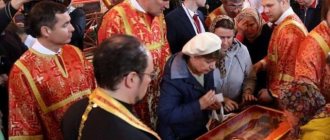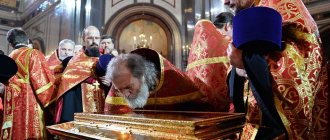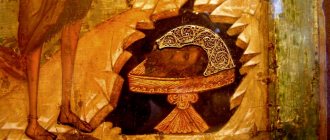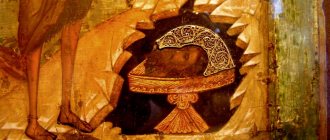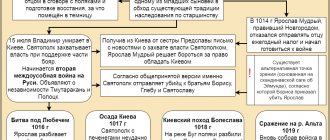The beginning of the veneration of the relics
The beginning of the veneration of relics dates back to the most ancient period of Christianity and apparently grew out of concern for the bodies of martyrs. Already in such an ancient monument as “The Martyrdom of Polycarp of Smyrna” (d. c. 155), it is said that the bones of the martyr, remaining after his burning, represent “a treasure more precious than expensive stones and purer than gold”; the community wanted to possess them in order to “be partakers of his holy flesh” ([Greek] χοινωνησαι τω άγίω αύνού σαρχίω). For the next (III) century, we find evidence of the veneration of the remains of martyrs in Cyprian of Carthage and Dionysius of Alexandria. The preservation of the relics of the martyr was perceived as his continued co-presence in the church community, as a manifestation of the victory over death accomplished by Christ, who gave the saint the grace of salvation, and repeated in the martyrdom. This perception determined the celebration of the memory of the martyr, the celebration of agape (meal of love) and the Eucharist over his grave. The preservation and veneration of relics was also closely connected with the affirmation of faith in the resurrection of the flesh; attacks on this teaching by the Gnostics, apparently, even served as an additional incentive for the veneration of relics. The intensity of the veneration of relics in the ancient period is evidenced by the actions of the persecutors of Christians, who tried to destroy the bodies of martyrs in order to prevent their veneration. The “Martyrdom of Polycarp” says that the Jews were taught to “report to the proconsul so that he would not give (the Christians) the bodies, lest they begin to worship him, leaving the Crucified One.” In the story of Eusebius [1] about the persecutions in Nicomedia, it is reported that the persecutors decided to “dig up the remains of the saints and throw them into the sea, so that no one would worship them and classify them as gods.” It is obvious that the pagans are struggling with the veneration of relics as a practice already known to them - understanding it, naturally, in the terms of pagan religion familiar to them.
I wonder what definition Wikipedia gives?
Material from Wikipedia - the free encyclopedia:
Relics (ancient Greek λείψανα, lat. reliquiae) are the remains of people canonized after death. The relics of saints are objects of veneration in Historic churches. The doctrine of their obligatory veneration was confirmed in 787 at the Second Nicene (Seventh Ecumenical) Council. According to this teaching, relics are carriers of grace and must be preserved and venerated for moral, edifying and liturgical purposes.
This definition confirms what was written above and provides complete understanding.
Criticism and ordering of the veneration of relics
The veneration of the relics takes on established forms after the end of the persecution. Certain forms of veneration of relics can be evoked at the end of the 3rd - beginning of the century. objections from part of the clergy. For example, Athanasius in his life of St. Anthony with disapproval mentions the custom established in Egypt not to bury deceased saints, but to keep their bodies in houses of worship. Particularly sharp were the attacks on the veneration of relics expressed by the Aquitanian priest Vigilantius at the beginning of the century; Vigilantius views the veneration of relics as a concession to pagan morals. The custom of burying loved ones next to the graves of martyrs also raised objections - the grace emanating from them, according to the ideas of that time, extended to the person buried nearby and contributed to his salvation. Such objections pointed to the need to streamline the veneration of relics and to its theological understanding (see first of all the treatise of St. Jerome against Vigilantius, written around 406). The ordering of veneration implied the placement of the relics in special buildings (martyriums) built in memory of the saint, the celebration of the annual commemoration with the service of the Eucharist on the day of the death of the saint (dies natalis), the placement of the relics (their particles) in special caskets that believers carried with them (this is where reliquaries, particularly sarcophagus-shaped reliquaries that may be supplied to churches).
Incorruptible bodies - myth or reality
The incorrupt bodies of saints, emitting incense, baffle science and many scientists to this day. After all, according to the laws of the Church, embalming people is prohibited, and the bodies of saints after death emit favorable odors, and each body smells unique.
Egyptian pharaohs are embalmed with special compounds, but they still emit foul odors. Studies have shown that the body structure of saints changes, so this is impossible without God’s intervention.
The Church sees in this phenomenon the future resurrection of people, as promised in the Bible. Not all saints remained incorrupt, but special grace was bestowed on the remains of St. Spyridon of Trimifunt and St. Alexander of Svir.
Relics of St. Alexander of Svirsky.
Transfer of relics
Particularly important for the veneration of relics was the development of the custom of transferring relics. The first cases of transfer of relics known to us date back to the middle of the century. In 356-357 Emperor Constantius, son of Constantine the Great, transfers the relics of the apostles Andrew, Luke and Timothy to the Temple of the Twelve Apostles (which served as the tomb of the emperors). St. Basil the Great (d. 379), in a conversation in memory of the martyr Julitta, speaks of the intactness of the body of the martyr - a clear indication that the body was carried out of the earth. There are also testimonies of Gregory the Theologian and John Chrysostom. The spread of this custom was very gradual; judging by the words of John Chrysostom (d. 407), in his time most of the bodies of martyrs were located in their burial places (i.e., in cemeteries located outside cities).
The excavation and transfer of relics could be perceived ambiguously; in the decree of Emperor Theodosius the Great in 386, these actions were prohibited. This prohibition indirectly reflects, apparently, the mentality of late antique pagan society, for which contact with the bodies of the dead is full of uncleanness and bad omens, cf. condemnation of the veneration of relics in the writings of Julian the Apostate (332-363) (“a procession with the bodies of the dead through a countless assembly of people, in the midst of crowded crowds, desecrating the eyes of people with the spectacle of a dead man that does not promise anything good”).
Nevertheless, the transfer of relics is established as a generally accepted practice, and in the second half of the century, in the decree of Emperor Leo the Great, the transfer of relics to sacred buildings or churches is permitted subject to the consent of the bishop.
In general, the same processes are taking place in the Western Church as in the Eastern Church. The first transfer of relics here was the removal from the graves and the placement in the new church of the remains of the martyrs Gervasius and Protasius, performed in 386 by St. Ambrose of Milan. And here, at the same time, this practice initially encounters an objection, cf. letter from Pope Gregory the Great (c. 540-604) to Empress Constance refusing a request to send a chapter or other part of the relics of the Apostle Paul: it says that disturbing the peace of the bodies of saints is considered in the West as unacceptable and sacrilegious (“intolerabile atque sacrilegum” - PL , 77, 702B).
Despite opposition of this kind, the transfer of relics is firmly established in the life of the church. The incentive for this is the living feeling of the presence of the saint in the church community that possesses his relics. Gregory of Nyssa writes that those who hold the relics embrace the living body of the saint, full of power; they feel his presence with all their senses and, shedding tears of reverence and love, turn to him prayers for intercession as if he were before them (PG, 46, 740B). Therefore, the discovery of the relics of a saint is perceived as the discovery of an intercessor sent by God to this community. Bl. Augustine of Hippo speaks of the discovery of the relics of the first martyr Stephen: “For so long his body lay hidden. It came when God willed it. It brought light to all countries, such miracles were performed by it.” St. Ambrose of Milan considers the discovery of the relics of the martyrs Gervasius and Protasius as a gift of God and grace sent to his flock during his ministry, and adds: “Although I did not deserve to become a martyr, I at least obtained these martyrs for you.” By transferring the relics of the saint to its temple (or city), the community gains a patron and patron. It is significant that the ceremony of transferring the relics was modeled on the ceremonial of the entry into the city (adventus) of the emperor (i.e., in the late antique understanding of the supreme patron of the civil community). It is this perception that explains the widespread disputes about which city or which temple should belong to the relics of this or that saint, as well as the frequent cases of theft of relics.
The first transfer of relics in the history of the Russian Church was the discovery of the relics of Vel. book Olga, who were moved to the Tithe Church of St. Vladimir. Following this, under Yaroslav in 1026, the bodies of Sts. were removed from their graves and placed in the church. Boris and Gleb, in 1072 they were solemnly transferred to the new church; another solemn transfer was carried out in 1115.
The transfer of relics acquires special significance due to the fact that the Church establishes the custom of building churches on the relics of saints. In this case, the relics were usually placed under the altar (sometimes also on one of the sides of the altar or at the entrance to the temple). This establishment apparently goes back to the custom of erecting churches over the graves of martyrs, which developed during the times of persecution. The rule that no church was to be built without the relics of saints, which were to be placed under the altar, was adopted by the Fifth Council of Carthage (canon 10). In the 8th century, however, there were still isolated deviations from this rule. The construction of churches without the placement of relics was prohibited by the VII Ecumenical Council. Here it was indicated that in those churches that were consecrated without relics, the position of the relics should be performed; if any bishop consecrated a new temple without relics, then he had to be excommunicated “as having violated church traditions” (canon 7) (one of the reasons for the adoption of this rule was the non-veneration of relics by some of the iconoclasts, against whom the VII Ecumenical Council was directed ). The relics were also placed in the altar of portable churches. Due to this development, the rule of not celebrating the Eucharist on the relics of saints was established in church practice. Therefore, in particular, in the practice of the Russian Church, relics are certainly sewn into the antimension and the priest can serve the Liturgy without the Throne (only on the antimension); in the Greek Church, relics are not sewn into the antimension, since it is not allowed to serve the liturgy not on the real Throne with the relics placed in it. In any case, the relics are considered a necessary condition for the celebration of the liturgy.
Saint Matrona is one of the remains revered in Russia
During her life, Matronushka, as her admirers affectionately call her, was a simple blind peasant woman, but very loving of God. Residents of the surrounding areas noticed that miracles were happening through Matrona’s prayers. As the saying goes, the folk path to it did not grow. The folk soothsayer could not refuse people’s prayers even when she fell ill, and she helped those asking until her death.
Guardian of the relics of St. The Moscow Orthodox monastery became Matrona, where people still come to ask Matrona:
- become an intercessor before God in resolving controversial issues;
- grant healing;
- set up a business;
- free from the curse of infertility.
Pilgrims often come with requests to help find something or someone, missing people.
Prayers to Saint Matrona of Moscow:
- Prayer for good luck and luck
- Prayer for purchasing a home
- Prayer for Marriage
Before approaching the shrine of St. Matrona, people must undergo a short training. You cannot approach holy relics in outer clothing; it is left outside, along with other things and bags. You can only bring flowers to the patron saint; the entire shrine is covered with them.
Saint Matrona
After reading a special prayer, you need to cross yourself twice and bow the same number of times with a deep bow, touching the ground with your hands, only after that you can kiss the sacred box. Then repeat the ritual of laying the cross and bowing.
Prayer to Matrona of Moscow
O blessed Mother Matrono, with your soul standing in heaven before the Throne of God, with your body resting on earth, and exuding various miracles by the grace given from above.
Look now with your merciful eye on us, sinners, in sorrow, illness and sinful temptations, our waiting days, comfort us, desperate ones, heal our fierce ailments, allowed by God to us through our sins, deliver us from many troubles and circumstances, pray to our Lord Jesus Christ forgive us all our sins, iniquities and falls, in whose image we have sinned from our youth even to this day and hour, and through your prayers having received grace and great mercy, we glorify in the Trinity the One God, the Father, and the Son, and the Holy Spirit, now and ever and ever. Amen.
According to the testimony of people who have visited Saint Matrona, the answer is felt immediately; if the person asking leaves in peace, everything will be fine. In case of anxiety in the heart, the request is rejected because it is unnecessary or does not bring any good.
Gifts of Grace
The veneration of relics is associated with their inherent gift of miracles, i.e. it is believed that the gifts of grace given to the saint are preserved in his relics. These gifts include, first of all, the power to heal various diseases and cast out demons. With the relics, according to John of Damascus, “demons are cast out, illnesses are healed, the weak are healed, the blind are despised, lepers are cleansed, temptations and sorrows disappear” [2]. Because of this, churches and monasteries that contain the relics of especially revered saints become places of pilgrimage (in Russia, such centers include primarily the Kiev Pechersk Lavra), and special communities of healed people and survivors of exorcism can form around them. Access to the relics could be either permanent or temporary. In the Greek Church, the relics were usually kept in the altar and offered for veneration to the people only on the day of remembrance of the saint and on temple holidays. Anthony of Novgorod in his “Book of the Pilgrim” (going to Constantinople around 1200) says that there “there is a monastery of the holy prophet Elijah and in it a church, and in it there are many relics of saints, and for the holiday throughout the church they put tables and on them laying the relics of the saints.” The relics could be carried in religious processions and placed on the sick. Many “relics of saints exuded myrrh, as John of Damascus specifically speaks of in his “Exact Exposition of the Faith.”
Incorruption
The relics of saints can be either whole bodies or just parts or particles of bodies. The custom of dismembering the relics of saints into parts, which were then placed in different churches, developed quite early and became especially widespread in the Greek church. Theodoret of Cyrus writes about the saints: “The courageous souls of the Victorious Bearers hover in heaven, as for the bodies, one coffin does not hide the body of each, but cities and villages, dividing them (the bodies) among themselves, call them saviors and doctors of the soul and body and they are honored as protectors and guardians” (PG, 82, 1449). This can lead to the plundering of the remains of saints. Thus, the body of the Patriarch of Constantinople Eutyches (+582) was almost stolen even at the time when it was carried to the temple for burial. Individual protests against such actions (for example, the already mentioned decree of Theodosius the Great in 386, which prohibited the theft of relics and trade in them, or the message of Pope Gregory the Great to Empress Constance refusing to send the head of the Apostle Paul) do not have a lasting impact.
Relics can be either incorruptible or perishable. The incorruption of relics as evidence of holiness is not a mandatory sign (see canonization) and receives significance only in a relatively late era. Many relics that have survived to this day, as well as numerous ancient testimonies, show the relics as the bones of saints. The story of the discovery of the relics of the first martyr Stephen says that his body turned to dust. Speaking about the relics of the apostles Peter and Paul, Bl. Jerome of Stridon calls them ossa veneranda, i.e. revered bones. The relics of the apostles Andrew, Luke and Timothy, transferred to Constantinople by Emperor Constantius, were placed in small reliquaries, i.e. were bones. And in later times, Athonite monks could specifically emphasize that the relics of Athonite saints represent exclusively bones, since, according to their explanation, they do not need supernatural signs to maintain faith.
Since ancient times, however, relics have also appeared in the form of incorruptible bodies. Thus, Basil the Great speaks of the intact body of the martyr Julitta. In later times, however, the incorruptibility of relics is often considered as evidence of holiness, i.e. as an action of grace permeating the body of a saint, as a supernatural state corresponding to the gift of miracles inherent in the relics. Thus, in praise of Patriarch Arseny (+1273), an opponent of the Latinophile policy of the Palaiologos, written at the end of the 14th century, it is said about his body, undamaged by corruption, bringing healing; the imperishable relics of the patriarch are contrasted with the “bloated” and ugly corpse of his persecutor Michael VIII Palaiologos; The incorruptible relics of the patriarch are considered as evidence of his holiness, and the decaying body of the emperor is considered as a result of the excommunication to which Arsenius subjected Michael VIII. The incorruption of relics as a sign of holiness acquires special significance in the Russian Church. The idea of incorruption as evidence of holiness entered into a complex and contradictory interaction with the popular idea of incorruption as a result of unrighteous death, which existed among both the Greeks and the Eastern Slavs (those who died under an oath, the dead in mortgage). In later Greek writings, the difference between the relics preserved in the form of whole bodies and the undestroyed bodies of the cursed dead may be emphasized: the former are beautiful, fragrant and withered, the latter are ugly, fetid and swollen like drums (cf. the above-mentioned description of the body of Michael VIII). And in this case, ideas about holiness in the Christian understanding and its signs could act as a radical rejection of traditional views.
Along with relics in the narrow sense of the word, similar veneration can extend to a number of other objects that were in physical contact with the saint’s body, primarily the fabric in which the relics are clothed (the so-called brandeum), wax from candles that stood on the saint’s grave etc.
Theological understanding of the veneration of relics
The theological understanding of the veneration of relics is based on the understanding of creation as a good act of God, which initially contains the good will of the Creator, God's plan for the salvation of the world and its transformation in the coming Kingdom of Heaven. The relics of the saints are particles of this transformed substance, filled with Divine grace; the Kingdom of Heaven is visibly present in them already in the present century. St. Ambrose of Milan in his homily about the saints. Nazarii and Kelsia calls the relics “seeds of eternity.” Accordingly, veneration of relics is understood as veneration of those who, in their spiritual feats, realized the Creator’s plan for the world. Bl. Jerome of Stridon in his letter to Riparius about Vigilance writes: “We do not honor, we do not worship, we do not serve the creature more than the Creator, we honor the relics of the martyrs in order to worship the One for Whom they suffered.” This is the judgment of Bl. Jerome about the relics fully corresponds to the well-known thesis of St. Basil the Great on the veneration of icons (“the honor given to the image is transferred to the prototype” - PG, 32, 149C).
The issue of veneration of relics was especially clearly developed by St. John of Damascus. Since a number of iconoclasts, along with the worship of icons, also denied the worship of the relics of saints, Damascene, in his Words in defense of holy icons, also speaks of relics. He writes that “the saints were filled with the Holy Spirit during their lifetime, but when they died, the grace of the Holy Spirit is present with their souls, and with their bodies in tombs, and with their figures, and with their holy icons - not essentially, but by grace and action (energy)” ([Greek] ού χατ“ ούσίαν, άλλά χαριτι χαί ένεργεία – PG, 94, 1249CD). The veneration of relics, just like the veneration of icons, expresses recognition of the significance of matter in the economy of salvation (in the transformation of the world). Damascene, pointing to the Incarnation as the starting point of this economy, continues: “I do not worship matter, but I worship the Creator of matter, who became matter for my sake, who deigned to dwell in matter and through matter accomplished my salvation... I honor and reverence the rest of matter, with through which my salvation was accomplished, as if filled with divine powers (energies) and grace” (PG, 94, 1245AB). Thus, the relics are the manifestation of a deified creature, through which the salvation of humanity is accomplished, the transformation of the substance of the world into the deified substance of the coming Kingdom.
